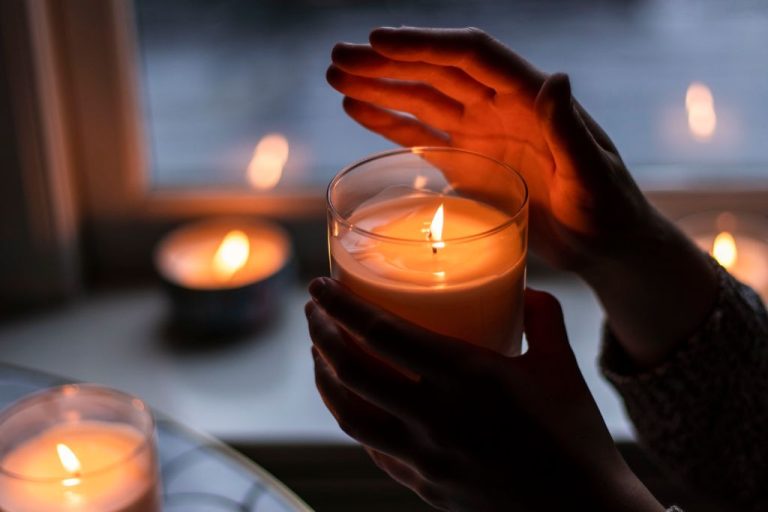What Happens When You Pray With A Candle?
Lighting a candle while praying or meditating is a practice found across many spiritual and religious traditions. The flame of a candle can be a powerful focal point during prayer, helping concentrate the mind and deepen spiritual intentions. Candles are used frequently in Christian, Buddhist, Hindu, Pagan, and New Age rituals and ceremonies. They represent the bringing of light into darkness, and the small wavering flame evokes spiritual illumination and the presence of divinity. Candles can be lit prior to silent prayer or meditation, during recitation of devotional chants or affirmations, or while reading holy scriptures. The duration of the candle’s flame can represent the length of time one devotes to their prayers. Many light candles of specific colors based on energetic associations or symbols of faith. Across these varied spiritual practices, lighting a candle during prayer provides beauty, focus, light, and a physical representation of hopes and intentions rising to the heavens.
Symbolic Meaning
Candles have long held deep symbolic meaning in spiritual practices across cultures and faiths. The flame itself is often seen as a representation of the divine, as light has often been associated with a higher power or God. The ascending flame of a lit candle can represent prayers rising up to heaven. The slowly melting wax symbolizes letting go and surrendering up our worries and burdens. The candle acts as an offering or gift when lit in ritual or ceremony, giving back light in return for blessings.
Focus and Intention
Lighting a candle can help you focus your energy and concentrate your intention for prayer or manifestation. The flickering flame provides a visual focal point to center your mind, and the ambience it creates sets the tone for sacredness and intentionality. As you gaze into the fire, let go of distracting thoughts and align your purpose. The candle becomes a conduit for directing energy toward your goal.
Setting an intention while lighting the wick allows you to clarify your purpose and amplify its power. Speak your desire either silently or aloud as you hold the intention in your mind. The physical act combined with mental focus magnifies the force of your will. Whether you are praying for help, healing, abundance or insight, see the candle as a catalyst for activating and transmitting your purpose.
Some people like to carve symbols or words into their intention candles to reinforce and broadcast their specific aims. As the candle burns down, imagine it carrying your hopes heavenward. The light serves as a beacon – an illuminated request, sending your focused thoughts out into the universe. Harnessing the candle’s radiance provides a ritual focus for manifesting your dreams.
Intercession
One of the most common uses of prayer candles is to offer intercession – carrying hopes, wishes, and intentions to the Divine through the flame’s light and smoke. When you focus deeply on a prayer or petition, visualizing it being lifted to the heavens in the candle’s glow and smoke, it can give your request wings to travel to a higher plane.
The flickering flame creates a ritual space to concentrate your mind entirely on your prayer and build faith that it is being carried upwards. As you repeat your petition over and over, meditating deeply on the words and imagery, the candle allows you to enter a contemplative state where you feel connected to spiritual realms. The dancing light can create a trance-like consciousness where your prayer feels amplified and energized.
Lighting a candle gives your intercession ceremony, intention and importance. The striking of the match and igniting of the wick starts the ritual, and watching the flame consume the wax focuses your mind. The candle transforms your prayer from words in your head to a tangible offering and sacrifice. Setting aside time for spiritual practice with a candle shows devotion and discipline to connect with the sacred.
Letting Go
Lighting a candle can help you release burdens, worries, or negative emotions. The physical act of lighting the candle can represent letting go of things that no longer serve you. As the candle burns down, it can feel like those burdens are released with the smoke and extinguished flame. This can provide a powerful mind-body connection for releasing and moving forward. The fire element is also traditionally associated with transformation and change. As such, incorporating fire through candle burning can help facilitate internal shifts and transitions. With focused intention, lighting a candle gives you space to consciously let go of what you no longer need. It creates a ritual for processing emotions and relieving yourself of energetic or psychological baggage. The flickering flame can have a meditative effect, putting you in a calm and introspective state of mind for releasing unwanted thoughts or feelings.
Ritual and Ceremony
Lighting prayer candles is a common practice across many faiths and spiritual traditions, especially during formal ceremonies and rites. The flames represent the light of the divine and are often incorporated into services for baptisms, weddings, funerals, and major holidays. Lighting candles is a symbolic way for worshippers to connect with the sacred and set an intention.
In Catholic and Orthodox churches, worshippers light candles representing prayers and illuminate the space around altars or sacred images. Lighting candles is part of the ceremonial order of the mass. In Judaism, candles are lit on the Sabbath and for holidays like Hanukkah. Hindu puja ceremonies involve lighting oil lamps or candle wicks as offerings. The flames honor deities and create an auspicious environment. Candles also feature in Wiccan rituals, where they represent the elements and directions.
Beyond organized religion, people light prayer candles for milestone events like births, graduations, and memorials. The candle flame pays tribute to the occasion. Overall, the ritual symbolizes focus, sanctity, and human hopes reaching toward the heavens. Prayer candles remind us to reflect on what truly matters.
Spiritual Light
Lighting a candle can have deep spiritual meaning and is commonly used as a symbolic invocation of enlightenment, wisdom and guidance. The flame of a candle is thought to connect the physical world with the spiritual realm. It’s warmth and glow can create a meditative focus and serene environment to open one’s mind and heart to receive insights from above. The dancing light of a candle is mesmerizing and calming, helping settle scattered thoughts and provide clarity. Many believe that praying in the presence of candles allows one’s petitions and intentions to ascend to higher realms along with the flickering flame. The candle then brings back enlightenment in the form of inner knowings, inspiration or discernment. It carries one’s prayers and hopes upwards while illuminating the path ahead with divine light and timeless wisdom.
Practical Benefits
Lighting a candle can provide some practical benefits that enhance the prayer experience. The warm glow of a candle creates an ambiance conducive to prayer and reflection. The flickering flame has a calming, hypnotic effect that can help still the mind and tune out distractions. This allows one to focus fully on prayer and be present in the moment.
Candlelight provides just enough illumination for reading prayer books or sacred texts without too much brightness to be distracting. The lighting complements activities like reciting devotional chants and prayers. The candle flame becomes a visual focal point for meditation during silent prayer.
Burning a candle signifies setting aside time specifically for sacred practices. The light serves as a reminder to maintain spiritual focus. The act of lighting a candle to start prayer helps transition into a mindset of reverence.
Candles are also practical when praying in places with poor lighting or no electricity. The flame can make a prayer space feel warmer and more inviting. For these reasons, lighting a candle is a simple way to enhance the prayer experience.
Safety Considerations
Lighting candles can create potential fire hazards, so it’s important to take proper safety precautions. Never leave burning candles unattended. Make sure to put them in stable, nonflammable holders on a sturdy, level surface away from anything flammable like curtains or paper. Keep them out of high-traffic areas and away from pets and children. Don’t burn them near open windows where drafts could blow curtains or papers into the flame. Make sure to extinguish all candles when leaving a room or before going to sleep. Have a fire extinguisher or water nearby in case of emergencies. Take extra care with long hair, baggy sleeves, or loose clothing that could catch fire. Limit burn times to avoid excessive wax buildup. Trim wicks to 1⁄4 inch before lighting to prevent smoking and flare-ups. Allow melted wax to fully harden before relighting to prevent tunneling. Make sure the candle is completely extinguished and the wick is no longer red before leaving it. With reasonable safety precautions, lighting intention candles can be an enriching spiritual practice.
Conclusion
In conclusion, praying with candles can greatly enhance one’s spiritual practice and connection with the divine. The candles represent focus, intention, and the light of the spirit. Their flame provides a centering visual point for prayer and meditation. The candle’s light dispels darkness and negativity, creating a sacred space. Lighting a candle sets the stage for mindful worship, contemplation, letting go, and opening up to guidance. It turns prayer into a multi-sensory experience, with the sights, sounds, smells and even warmth of the candle making it more tangible and vivid. Candles connect us with ancient traditions and rituals that tap into a sense of the eternal. With care and wisdom, the candle becomes a conduit for sending intercessions heavenward. The candle flame is a symbol of hope – a reminder that there is always light if we know where to look. By incorporating candles into daily spiritual practice, we open our hearts and lives to the presence of the sacred.



